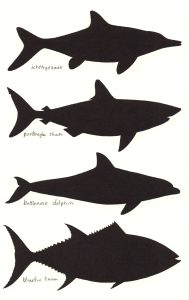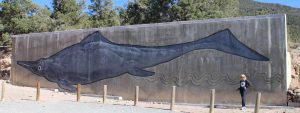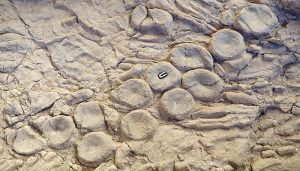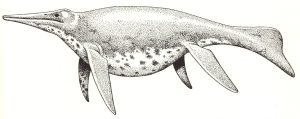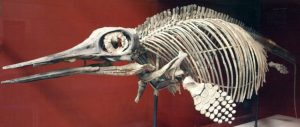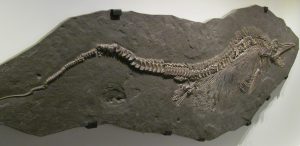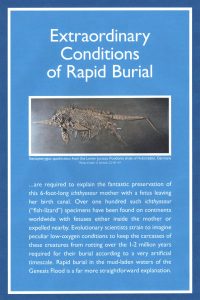Ichthyosaurs (“Fish Lizards”) are extinct marine reptiles whose fossils provide great evidence for design and the global Flood at the time of Noah. At first glance many of them look much like dolphins of today. There is quite a bit of variation in the fossils identified as ichthyosaurs; so much so that the biblical creationist might suggest that there could have been more than one created kind. However, they all showed great design, a fact that speaks against the evolutionist’s call for convergent evolution in this group of animals. Some genera were so streamlined as to suggest that they may have been able to swim as fast as a tuna fish. The average ichthyosaur was 6-15 feet long, but some fossils have been found in the rock record that are thought to indicate that some ichthyosaurs grew to be as much as 50 feet or more in length. It is always difficult to nail down the size of the largest fossil because generally there is a lack of complete remains discovered for any one species or genera. All ichthyosaurs swam through the water using a side-to-side movement of their tails, just like a shark or tuna.
Fast-Swimming Silhouettes-Ellis p. 62.
Evolutionists are confused by the extinction of these marine reptiles because they look to be so well designed and so well adapted to living in the oceans of the earth. Why would they go extinct, they ask? The creationist has a logical answer using the biblical presupposition of the global Flood. We can assume that since Noah did not take sea creatures onboard the ark they were therefore mostly wiped out by the cataclysmic actions of the Flood. Most experts believe that ichthyosaurs were cold blooded. With an expectation that the oceans would have been unusually warm due to volcanism during the Flood the ichthyosaurs and other marine reptiles could have had great difficulty surviving. Ichthyosaurs were air-breathers and so could not have long avoided the catastrophic actions at the surfaces of the waters during the Flood. While many sea creatures survived the Flood the marine reptiles (e.g. ichthyosaurs, plesiosaurs, mosasaurs, pliosaurs) evidently did not.
Incidentally, most people have read about the historical discovery in England by Mary Anning around 1814 of the genus name Ichthyosaurus. Since that time there has been a large amount of reclassification of the ichthyosaurs which is ongoing. Today the genus Ichthyosaurus is considered to have been applied to another discovery in 1821. The current ichthyosaur scientific classification is as follows: Domain-Eukaryota, Kingdom-Animalia, Phylum-Chordata, Class-Reptilia, Order-Ichthyosauria, Family-Ichthyosauridae as well as other families, after which follows a long listing of genus and species names.
In this article I will focus on just three genera of ichthyosaurs: Shonisaurus, Ophthalmosaurus, and Stenopterygius. Using these genera, I will explain other reasons for the fossils of the ichthyosaurs being great evidence that matches the creationist belief in God as their Designer and the reality of a global Flood some 4,500 years ago.
SHONISAURUS: Shonisaurus is one of the largest of the ichthyosaurs and is the state fossil of Nevada. In the remote high desert of Nevada about 150 miles east of Reno is located a graveyard of these animals. Named for the nearby Shoshone Mountain Range where the graveyard was formally discovered in the late 1920s, the fossil remains of at least forty of these whale-sized beasts have been studied over the last century with formal work beginning in 1954. Not all of the fossils could be excavated so what remains is preserved at the Berlin-Ichthyosaur State Park inside a protective building. The fact that the animals in the grouping were all aligned in about the same north-south direction would match the creationist expectations of the actions and results of the global Flood. An unusual attribute of Shonisaurus is that its large 5-foot-long front flippers were about the same size as its rear flippers. Not one of these skeletons has been found to be complete which is another indication of catastrophe.
It is interesting to note that the Shonisaurus fossils were found due to late 19th century silver mining activity that took place nearby. The Nevada State Park is also the location where the mining town and equipment ruins have been preserved alongside the fossils. If it weren’t for the silver mining that took place at the location one could surmise that the fossil graveyard might not ever have been discovered. Park rangers like to mention that the silver miners used Shonisaurus fossilized vertebrae for dinner plates.
Scale Mural of 50-foot-long Shonisaurus at Berlin-Ichthyosaur State Park in Nevada.
Shonisaurus Fossils Close-up at Berlin-Ichthyosaur State Park.
Paleontologist’s Artistic Reconstruction of Shonisaurus-Ellis p. 91.
Note the Similarities and Differences from the State Park Mural.
OPHTHALMOSAURUS: The genus name Ophthalmosaurus means “eye lizard” and for good reason. While all ichthyosaurs had relatively large eyes, and a bony sclerotic ring to support their large eyes, Ophthalmosaurus was the champ so far as the ratio of eye size to body size. According to the fossils so far found, the animal grew to be up to about 15 feet long and had eyes 8 inches in diameter. Consider that a15-foot pilot whale has eyes about one inch in diameter and a 100-foot blue whale has eyes about 8 inches in diameter. So far as is known the blue whale is the largest animal ever to have lived.
Why would this ichthyosaur have such large eyes? A logical answer would be that all ichthyosaurs dove to great depths for food, and the larger eyes allowed for better sight in that condition of minimal light. Perhaps Ophthalmosaurus adapted to a greater extent than other types or was designed in the beginning specifically for adaptation to those greater depths by its Creator. At any rate design makes more sense to the creationist than does random chance evolution.
Skeleton of an Ichthyosaur Highlighting Large Eyes and Sclerotic Ring.
Paleontologist’s Artistic Reconstruction of Ophthalmosaurus-Ellis p. 97.
STENOPTERYGIUS: Stenopterygius is a genus of ichthyosaur well-known from fossils found in Europe, especially Germany. The name was derived from the Greek stenos that means “narrow” and pteryx that means “fin” or “wing.” (Think of the most famous fossil of all, Archaeopteryx.) Many of the fossils of this genus of ichthyosaur have been found in the close-grained shale of the Holzmaden region of Germany. Even more interesting is the fact that many of the Holzmaden ichthyosaurs are females with embryos visible. In the 1990s as many as 35 new ichthyosaur fossils were discovered at Holzmaden each year and the total found in the 20th century alone is estimated as being on the order of three thousand.
Detailed Skeleton of the Ichthyosaur Stenopterygius from Holzmaden that Close-Inspection
Shows Seven Unborn Babies and One Baby in the Birth Canal.
Stenopterygius Fossil Sketch with One Birth in Process and Three Babies Inside.
The babies found in various Stenopterygius skeletons are normally oriented so that the head is the last part to leave the mother. That makes sense since the babies must quickly be able to swim up to the surface to breathe their first oxygen. If they had come out of the birth canal headfirst, they would have drowned before being able to make it to the surface. If a Stenopterygius fossil should show the opposite orientation at birth that means that the baby’s position was modified by the actions prior to and at the time of burial. Another point of interest is that the babies were designed so that their heads and jaws were proportionally huge compared to the adults. That too makes sense since they would need to be able to fend for themselves quickly after being born.
Stenopterygius from Holzmaden Frozen with Baby at time of Birth. Note the Proportion of the
Baby that is Head and Jaws Compared to the mother.
The evolutionist explanations for how these birth events were frozen in time and fossilized are laughable. I won’t even repeat them here. There is only one way this can reasonably be explained and that is rapid burial in tons of mud. Today, if this sort of fossilization was even occasionally occurring there would be piles of large animals recently fossilized all over the surface of the earth. But there is no evidence of this anywhere. The one and only explanation is rapid burial in the global Flood some 4,500 years ago.
Paleontologist’s Reconstruction of the Ichthyosaur Stenopterygius-Ellis p. 83.
Museum Sign at MSHCC Dinosaur & Fossil Museum Explaining Ichthyosaur Rapid Burial.
Great are the works of the Lord; they are pondered by all who delight in them. (Psalm 111:2 NIV.)
J.D. Mitchell
Resources:
Ellis, Richard, Sea Dragons-Predators of the Prehistoric Oceans, University Press of Kansas, 2003.
Sarfati, Jonathan & Tay, Joel, Titans of the Earth, Sea, and Air, Creation Book Publishers, 2022.
Sarfati, Jonathan, “Ichthyosaurs-Evidence for a Recent Global Flood,” Creation, 37-1 2015, p. 38.
Wieland, Carl, Dragons of the Deep-Ocean Monsters Past and Present, Master Books, 2005.
